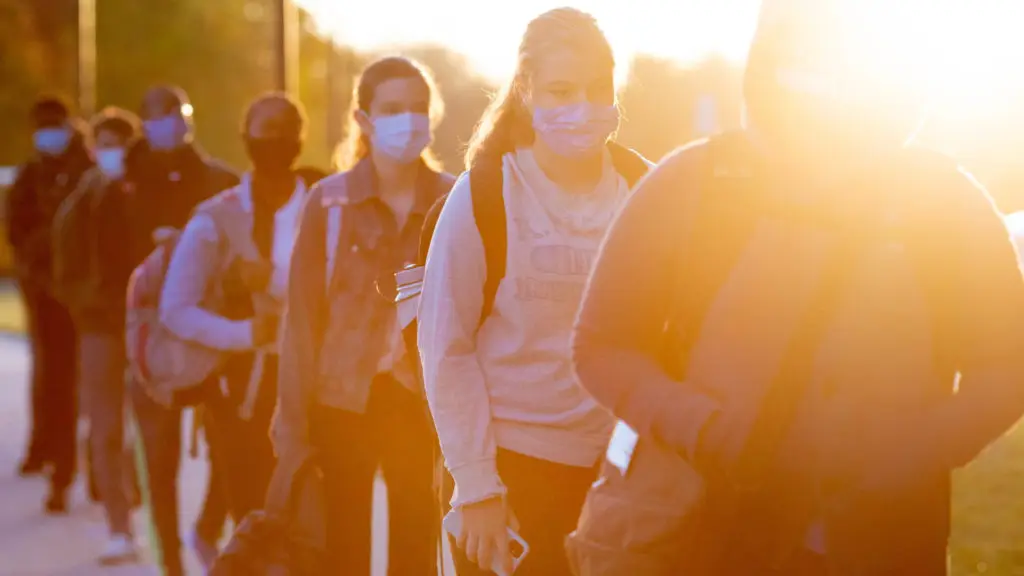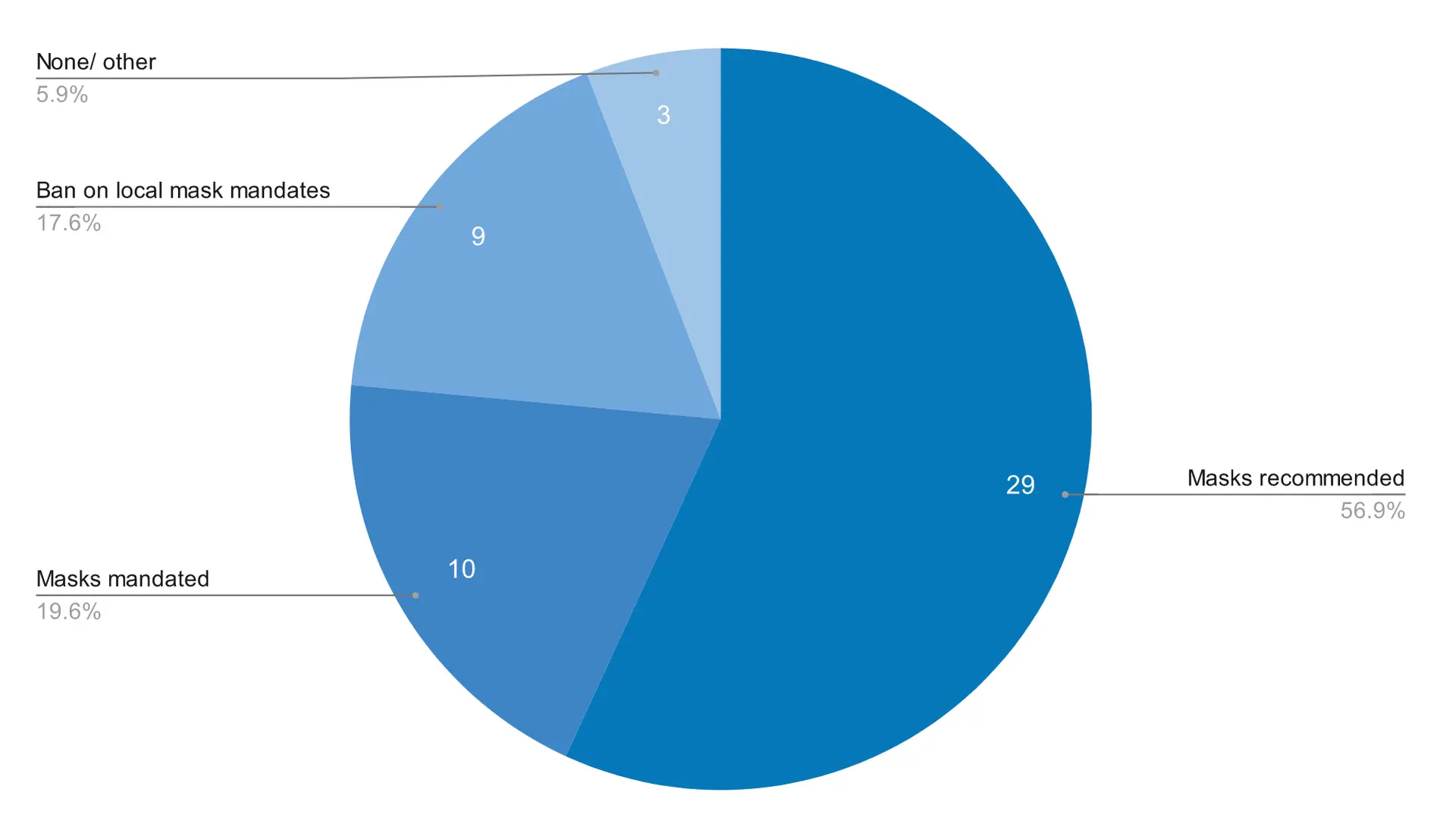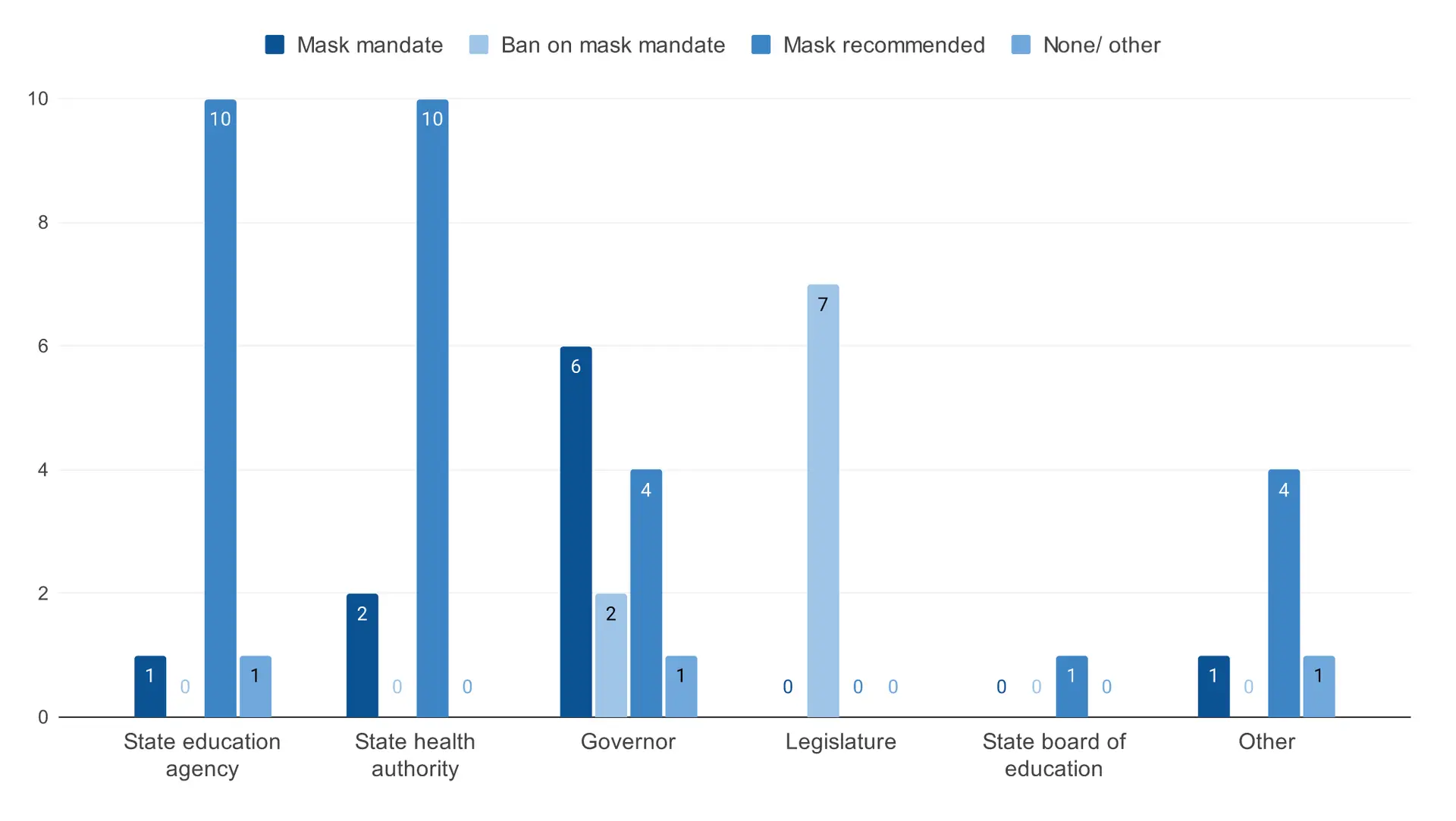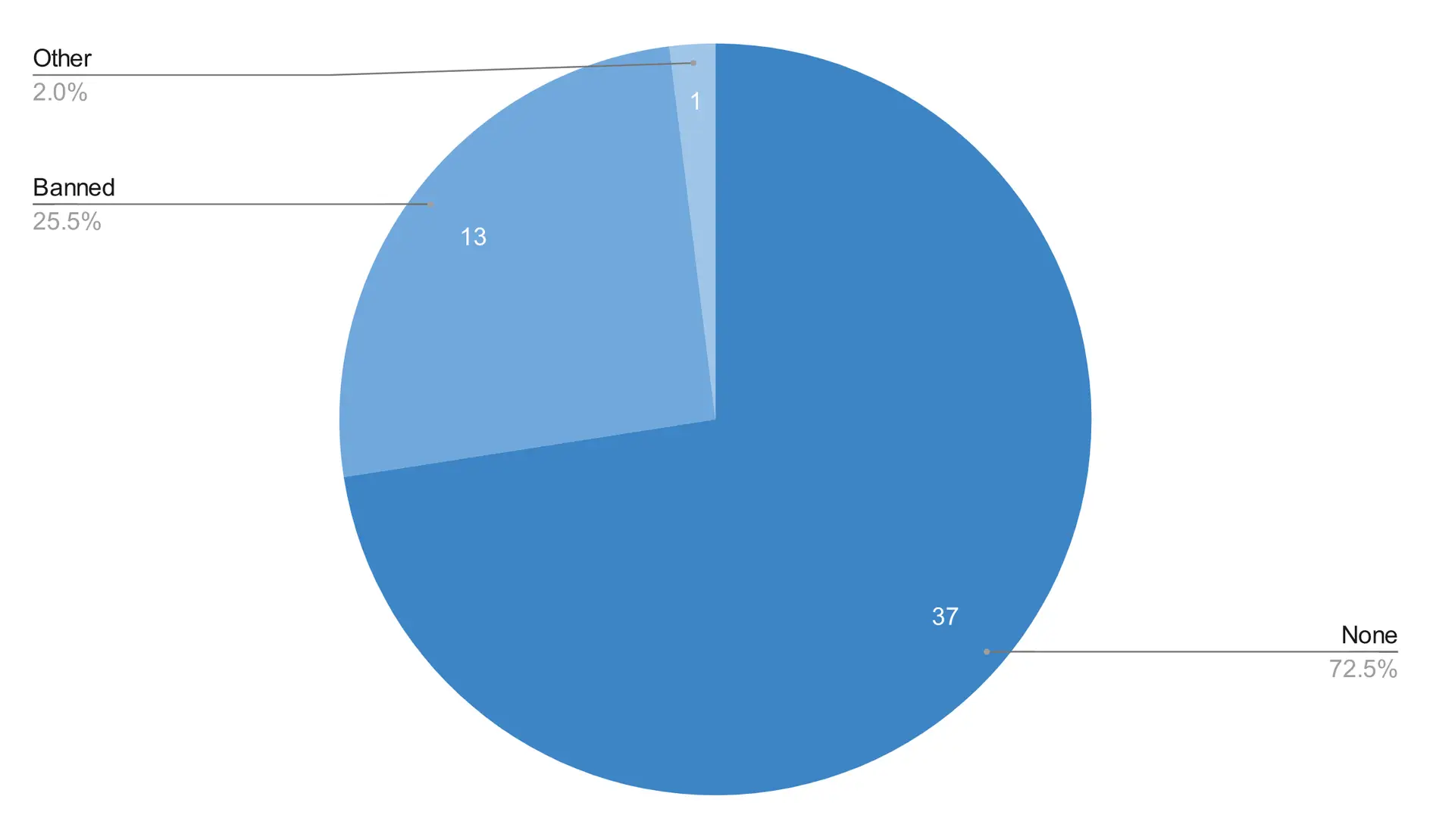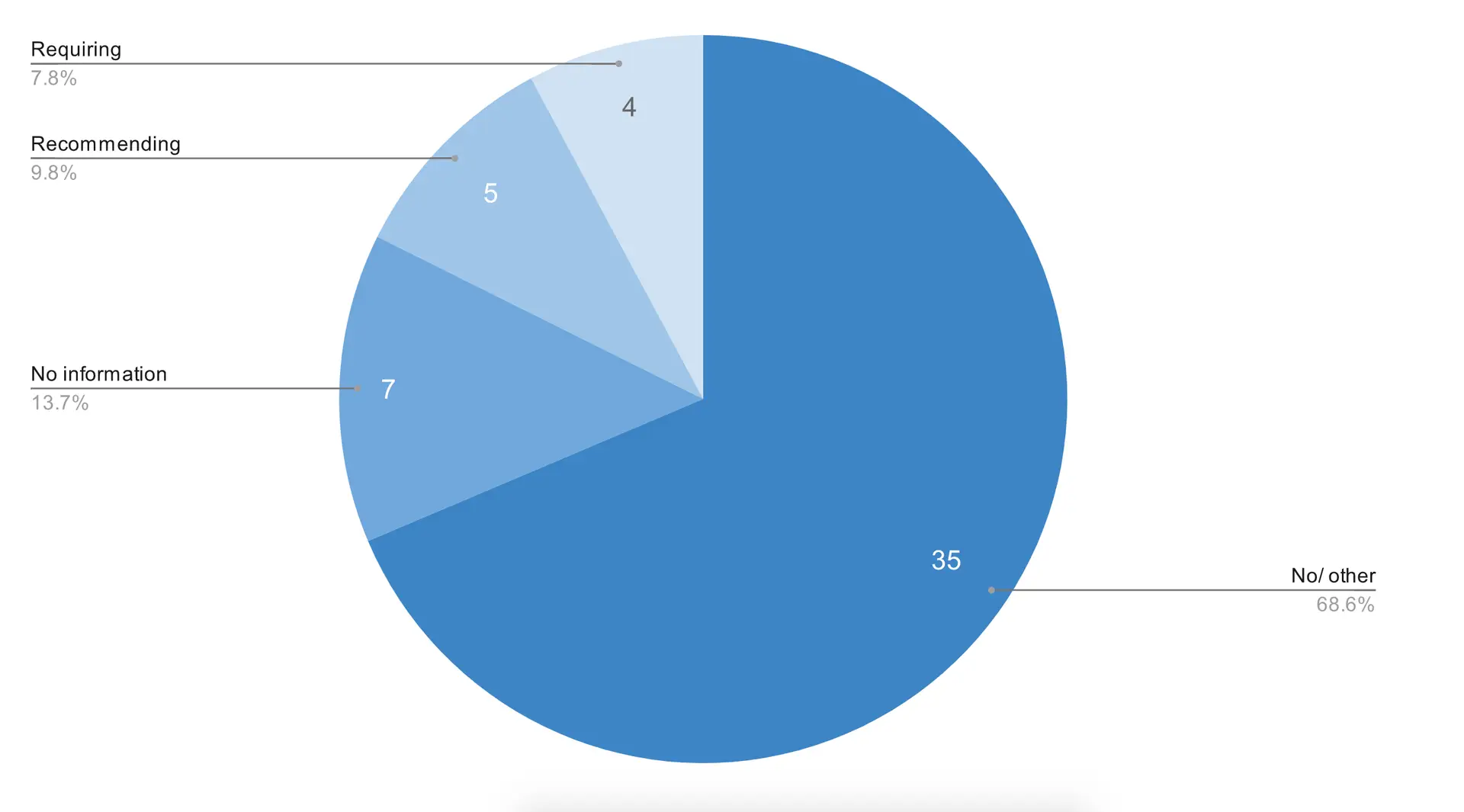Schools around the country are once again scrambling to keep students learning in person against a rising tide of COVID-19 cases.
Whether they succeed will hinge on how local officials are able to mount effective mitigation strategies that keep students and staff safe amid an escalating public health crisis. States have a critical role to play in supporting effective local action; they must not repeat the mistakes of 2020, when many sidestepped their role in supporting districts’ reopening plans.
In an effort to track the state of school reopening against the backdrop of an ever-changing pandemic, CRPE reviewed the fall 2021 reopening guidance for all fifty states and Washington, D.C., between July 29 and August 6, 2021. Our new 2021 state response database includes the most pressing indicators that state and local leaders are facing in reopening schools this fall: state policies on masking, vaccines, full in-person instruction, virtual learning options, and continuity of learning plans.
This summer’s optimism about the direction of the pandemic has left few states prepared to adequately support and oversee district planning for keeping schools open. While state leaders are increasingly stepping into conflicts over mask and vaccine mandates, many have, once again, ceded their role in ensuring districts keep students safe and learning.
States stepping in to settle the growing conflict over masks in schools
Twenty-nine states are recommending masks for students in schools this fall—a striking decline from last fall, when forty-four states did so. As Figure 1 illustrates, the remaining states are split between the extremes. Ten are mandating masks in schools, and nine are enacting bans on mask requirements. These contrasting policies are largely split along political party lines, with the bans on mask requirements more likely to exist in states under Republican leadership.
In Alaska, Gov. Mike Dunleavy (R) explained that local flexibility on school mask policies is important because he believes the choice to wear a mask is personal and the state is no longer in a state of emergency. Local flexibility, however, cannot resolve the growing rancor over masks in some localities. When the Anchorage school board and superintendent supported a universal mask mandate, Mayor Dave Branson and nearly 1,000 parents spoke out against it. Such confusion over precautions may leave some families and students worried over whether classrooms are safe, undermining the national effort to get all students back to learning in person.
Figure 1. State mask policies for students, fall 2021
Figure 2 illustrates which state offices enacted mask policies for K–12 schools. Notably, in seven of the nine states imposing bans on mask mandates (Arkansas, Arizona, Iowa, North Dakota, Oklahoma, South Carolina, and Utah), these policies were enacted by state legislatures. Florida and Texas are the only two states to ban mask policies by gubernatorial executive orders. Six of the nine states—Arkansas, Arizona, Florida, Oklahoma, Texas, and Utah—have overlapping bans on vaccination requirements for students and teachers.
Figure 2. Which state office took action on school mask policies by type?
The fight for authority over COVID-19 policies between governors and state legislatures played out acutely in North Dakota this spring. In April, the legislature passed House Bill 1323 prohibiting schools from requiring masks for students or staff. Shortly after, Gov. Doug Burgum (R) vetoed the bill, stating that it stripped the governor’s office and other state health officials’ authority to use life-saving tools. However, the North Dakota legislature overrode the veto.
Similarly, in Arkansas, Gov. Hutchinson (R) asked for the legislature to undo a law he signed in spring banning mask mandates. The Arkansas legislature was not willing to cooperate, and a state circuit court judge has temporarily blocked the state from enforcing the ban on local mask requirements.
Few states take an aggressive stance on vaccine requirements
While the debate over masks may be heating up at the state level, most state leaders are leaving the issue of vaccination up to districts. Roughly three-fourths (thirty-six) have left the decision of whether students or teachers must be vaccinated up to local officials. Still, we found that nearly one in four (thirteen) states have enacted bans on COVID-19 vaccination requirements that will limit action in local school districts (see Figure 3). The governors of Florida, South Dakota, and Texas banned local authorities from requiring teacher and student vaccinations in schools through executive orders, while the other ten states enacted bans through state legislation.
Figure 3. State requirements for teacher and student vaccines
Of the thirteen states banning COVID-19 vaccination requirements, the laws emerging from Arizona, Montana, and Utah only apply to the vaccine while it is under Food and Drug Administration emergency authorization. Therefore, when the COVID-19 vaccines receive final federal approval, these laws will no longer apply.
National teacher unions previously suggested vaccine mandates should be negotiated by local unions and school districts, but the tides seemed to shift when American Federation of Teachers president Randi Weingarten said Sunday that she will bring together union leadership to reconsider and would recommend vaccine requirements for teachers. Still, so far, only California and Washington, D.C. require teacher vaccinations.
Few states making moves to report teacher vaccination rates
Transparently reporting vaccination rates can help families evaluate the health risks associated with in-person instruction. Yet to date, few states report this information publicly.
At least five states—Indiana, Maine, Michigan, Utah, and West Virginia—are planning to track teacher COVID-19 vaccination status this year. Most of these states are sending out monthly surveys to collect voluntary, self-reported data on how many educators are vaccinated, which may not provide a complete or accurate picture.
The Maine Department of Health and Human Services (DHHS) stands out for its effort to track teacher vaccination rates at the school level, modeling the work done tracking vaccination rates of staff at healthcare facilities.
Because most state health agencies report vaccination coverage to public dashboards by age group and county, it is easier to understand the extent to which students within districts are vaccinated. In some cases, as in Illinois, the state education or health agency is prompting local school authorities to access statewide immunization databases to review student immunization records—an important step toward schools treating COVID vaccines like other mandatory immunizations, such as those for smallpox or measles.
The expectation for in-person or virtual learning remains unclear across many states
In a change from last year, our analysis of reopening plans found twenty-four states and D.C. are requiring districts to provide in-person instruction this fall (see Figure 4), and nineteen states are recommending in-person instruction be made available, leaving decisions to maintain full in-person learning or move into emergency remote learning up to local district leaders.
Figure 4. State policies on full in-person instruction for fall 2021
Only eight states and D.C. are requiring or recommending that schools provide a virtual learning option this fall.
Figure 5. State policies on virtual learning options this fall
However, the majority of states take no definitive stance on the role remote learning will play through the school year. And eight states—Connecticut, Florida, Kentucky, Massachusetts, New Jersey, Tennessee, Texas, and West Virginia—have restricted districts from offering certain types of remote or virtual learning options in the fall.
A new Tennessee rule limits school districts’ hybrid and remote learning unless a state of emergency is in effect and permits students to enroll in state-approved virtual schools, prompting a raft of new district-sponsored virtual schools. Similarly, in Texas, school districts will receive state funding only for students enrolled in state-approved virtual education programs. Districts are still permitted to offer other forms of remote instruction but would forgo state funding for those students.
Stronger state leadership is needed to keep students safe and learning
One thing everyone agrees on is that we must keep kids safe and learning throughout this year. Yet many districts are paralyzed as they struggle to create and communicate contingency plans, buffeted by the winds of changing federal guidance and heated local politics. Forty-two states require districts to submit continuity of learning plans, but only thirty-five require districts to share the plans with the public.
Further, the process for reviewing and updating plans throughout the year runs the gamut from random compliance checks in Texas to full-on plan-do-study-act cycles in Washington.
Regardless of the federal requirements under the American Rescue Plan to submit and communicate reopening plans, it seems that many families across the country will be in the dark about what to expect this fall and beyond.
Districts and schools need clear and coordinated support from all layers of state and federal government. States can set clear expectations for districts to adhere to layered COVID-19 health and safety precautions and communicate early and often to the public about how they are tracking these practices.
States not requiring universal mask policies must set clear expectations for schools to follow other layers COVID-19 mitigation strategies, such as COVID-19 vaccinations, testing, ventilation, and physical distancing. States must also ensure that students who need to learn remotely can access high-quality remote instruction. This will likely mean offering a contingency plan for a potential tidal wave of new enrollments for virtual options as escalating cases renew fears about transmission, especially for vulnerable students and families.
The impact of failing to take these steps could be profound, as families once again lose trust in the systems charged with keeping kids safe and learning. States can act now to ensure local school systems are keeping kids safe and learning all year long.



